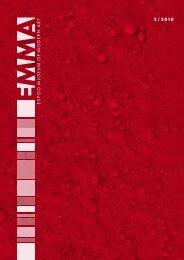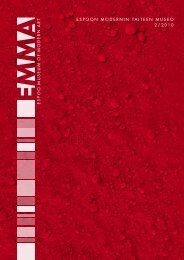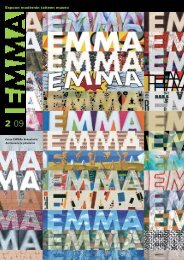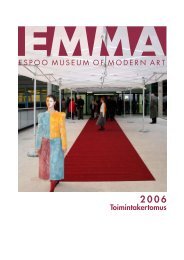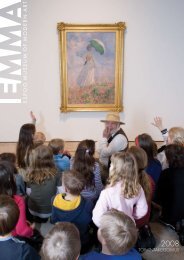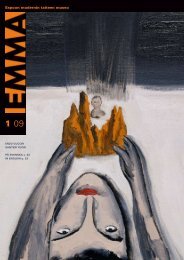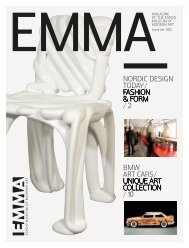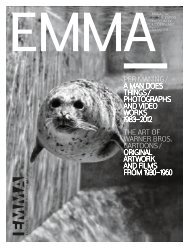EMMA Magazine 3/2011
EMMA Magazine 3/2011
EMMA Magazine 3/2011
- No tags were found...
You also want an ePaper? Increase the reach of your titles
YUMPU automatically turns print PDFs into web optimized ePapers that Google loves.
Excerpts from the programme:Comic artist Kaisa Lekatells of bike trips she’s made over the past fiveyears in Finland, Norway, Sweden, Germany,France, Iceland and Russia, illustrating themwith photos and comic strips.On with your trainers and over to WeeGee 13.–16.10.You’ve never run ina marathon like this!WeeGee and <strong>EMMA</strong> are celebrating their fifth anniversarywith a four-day Art Marathon on 13–16 October.Participants are invited to enjoy the cultural benefits of the place in an entirelynew and sporty way. At the art fuelling stations along the track in the exhibitioncentre, marathon runners can make instruments and medals from recyclingmaterials, test their dancing skills and build fairy castles.Thurs. 13.10. 11am–6pm,birthday, free entry. Free gamesbag for the first hundred.Fri. 14.10. 11am–12pm,S Group customer-owner day,Adults 5€ with S Card.Sat. 15.10. 11am–12pm,Sun. 16.10. 11am–5pm.Entrance 10€ adults,under 18 and over 70 free.Ticket includes games bagand marathon wristband.Free bus to WeeGee from Helsinki,Kiasma bus-stop.Thurs. 10.40am, 2pm, 4pmFri. 10.40am, 2pm, 5pm, 7pm, 9pmSat. 10.40am, 2pm, 5pm, 7pm, 9pmSun. 10.40am, 1pm, 3pmSaturday’s natural gas bussponsored by Gasum Oy.Fairy Tale Marathon organisedby the DCA Dance SchoolThe DCA Dance School brings fresh winds fromthe world of dance to the WeeGee Art Marathon.Performers include young talented winners fromthe DCA Dance School’s Finnish Championshipsand the semi-professional DCA Dancers.The art marathon’s Silence Walkarranged by Silence ry seeks to improve yourwell-being through silence. Take the whole familyorienteering with a collector’s treasure-trove map.Fulfil yourselfCome and make medals and badges from recyclablematerials with the Finnish Broadcasting’sOlotila team and Recycling Designer Aija Rouhiainen.Olotila inspires an everyday where you can turnsomersaults, test your limits and win, have fun andgenerally fulfil yourself.Musical instrument workshopCome and make your own instrument fromrecycling materials. From a floorball ballto an ocarina!Wii Games RoomWii Sports Resort andWii Fit Plus and balancer boardMeet well-known figuresfrom the world of sport and art in thefootball tricks room. All in support ofrecreation activities for SOS Children’s Village.Build a fairy castletogether with Lego and Palikkatakomo,the Finnish Lego Hobbyists Group.Star of Africaboard game – 60 years old!Star of Africa World Cup qualifying heats.xxxxxxxxxxxxxxxxxwill appear in the café.Check the day’s programme:www.emma.museum/maratonWatch out for any possible changes!3
Sommitelma,1957Ruukku Fezistä, 1954, öljy, Yksityiskokoelma.Kollaasi” Through my painting I wish to convey theimpression of an harmonious peace fromsomewhere beyond ordinary existence.”4
Text Sanna TeittinenExhibition at <strong>EMMA</strong>, 28.9.11–8.1.2012Anitra Lucander’s (1918–2000) fascinationfor ancient civilisations and religions had amajor influence on her work and moulding herconcept of art. She saw art as a means of escapingthe mundane, everyday and superficialin the direction of an ageless and permanentexpression. India and its religions had a particularinfluence on her idea of painting, for to herit was also meditation. Her works are permeatedby a refined spirituality and timelessness.Her work in the 1950s made Anitra Lucanderone of the earliest pioneers of abstract art inthis country, helping to reshape the visual artsin the post-war period. She was an extremelyversatile and innovative artist, and the enthusiasmthat characterised her three-decade longcareer led her to experiment in many branchesof the arts. Not only was she a painter, but alsoa colour designer, draughtsman and graphicartist. Lucander’s wide interest in materials ledto her making paper collages from the 1950sonwards and later, from the 1960s, to textileappliqué and a variety of other experimentswith different materials.Due to her sensitive and profound sense ofcolour, Lucander was employed as an advisoron colour design in buildings during the 1960sand 1970s, collaborating with such architectsas Aarno Ruusuvuori, the designer of theWeeGee building.Anitra Lucander’s works are not only distinguishedby their spirituality and timelessness,but also reveal her enthusiasm for travelling,different cultures, architecture and colour. Colour,however, remained uppermost. Thoughher form language, materials and techniqueschanged over the decades, colour continuedto play the leading role.Kirjoittaja on näyttelyn kuraattoriAnitra Lucander – Poet of ColourMoskeija II,1968,öljy kankaalle,104 x 104.Yksityiskokelma.5
” Each place has itsown colour scale …Athens I remember as ochre,Istambul blue-grey.Paris, too, is blue-grey.”Huvudstadsbladet,24.2.1969Anitra Lucander. Private collectionAnitra Lucander in Chandigarh, India, in the mid-1960s. In the background is theHigh Court building, one of the many buildings designed for the city by Le Corbusier.Anitra Lucander in Tapiola and the WorldFrom exemplary family girl to artistAnitra Lucander (1918–2000) came from anaffluent, multicultural background, a mixtureof Russian, Estonian and Finnish-Swedish.To begin with it looked like a conventional familystory: well brought-up girl marries early andgives birth to two children. But then came divorceand everything changed. By the secondhalf of the 1940s, she was a single-parent bringingup two small boys, simultaneously studyingin the evenings at the Helsinki Free Art School.To the Tapiola Nallenpolku studioAfter the war there were few decent studiosavailable in Finland and Lucander was constantlyon the outlook for a better place to liveand work. She acquired her first proper studioin 1955 in Nallenpolku, Tapiola, where the Artists’Association of Finland had had built anatelier complex. There she lived with her sons– at that time the first and only female artist – ina high-ceilinged sculptor’s studio for five years,from 1955 to 1960. Thanks to having a real studio,Lucander could at long last fully concentrateon being an artist.Travelling as a way of lifeSweden, France, Italy, Spain, Greece, Morocco,Egypt, Jordan, Turkey, Israel, Iran, India, Nepal.Travelling and the resulting experiences profoundlyinfluenced Lucander’s art. She begantravelling in 1948, first to Sweden, and then almostevery year a bit further afield. Open-mindedlyand courageously she turned travelling intoa way of life.Anitra Lucander mostly travelled alone,though occasionally with a friend, one of hersons or a colleague. She did not paint on hertrips as she preferred to travel light, and also ona very tight budget. Everything was of interest –the people, culture, architecture, temples andmosques. What she remembered most from hertravels were the colours. She was particularlyenchanted by the strong turquoise colour ofmosques.Serious illness during the 1970s and 1980sprevented Lucander from travelling any more.Text Hannele SavelainenWhy is <strong>EMMA</strong> inWeeGee such asuitable place foran Anitra Lucanderexhibition?The Anitra Lucander – Poetof Colour exhibition is part of<strong>EMMA</strong>’s series of classicspresenting the leading lightsof Finnish modernism. It isparticularly suitable for <strong>EMMA</strong>as so many things connect theartist to Tapiola and WeeGee.She had her first real studioin Tapiola’s Nallenpolku in the1950s. Also she had close tieswith Hagalund Manor, workingin one of the outhouses duringthe summers in the early 1960s.It was via colour design thatAnitra Lucander becameassociated with the architectAarno Ruusuvuori, WeeGee’sdesigner. She worked asRuusuvuori’s colour advisorat the end of the 1960s onHelsinki’s Neo-Classical centrein the area around the marketsquare.Anitra Lucander andMarianne Maury in Paris,1955. Private collection.Anitra Lucander in her Nallenpolkustudio, Tapiola, 1956. Huvudstadsbladetarchives.In 1961 Anitra Lucander acquiresa loft studio in Vironkatu, Helsinki.Private collection.6
Text Päivi TalasmaaPortrait Aleksi KinnunenYang Fudong’s videoinstallations at <strong>EMMA</strong>Yang FudongSeven Intellectuals in Bamboo Forest, part 5. 35mm film transferred to DVD, 91 min, 2007This autumn <strong>EMMA</strong>’smedia galleries will bedevoted to the contemporaryChinese artist Yang Fudong,offering the public theopportunity of seeing hisvideo installations SevenIntellectuals in BambooForest (parts 3-5), East ofQue Village, as well as stillsfrom the video No Snowon the Broken Bridge.Yang Fudong is one of theleading lights of Chinesevideo and cinema art,a brilliant interpreterwith a magical touchto his camera.Chinese experimental art has undergonea major transformation in the last fewdecades. Thanks to the incredible economicboom, contemporary art has experienced arenaissance. Yang Fudong’s works provide anexcellent picture of what is happening in Chinesecontemporary history and art.The artists who rose to prominence in the1990s had been born in the 1970s and 1980s,and could also travel abroad. This made it possibleto forge contacts and relations on the internationalart scene. But unlike the preciousgeneration that fled China, they stayed in theirhomeland. These young artists have also hadbetter opportunities to work and earn than theirpredecessors.Yang Fudong, who was born in Beijing in1971 and now lives in Shanghai, studied at theChina Academy of Fine Arts in Hangzhou, nearShanghai. This progressive school was one ofthe few places where it was possible to becomeacquainted with international contemporaryand video art. Fudong’s first video was I Lovemy Motherland, which was originally shown ina Shanghai shopping mall as was the customin those days.The First IntellectualYang Fudong’s reputation grew rapidly and in2000 Ai Wei Wei, perhaps China’s most famousartist, invited him to participate in theShanghai Biennale with a series of three photographsentitled The First Intellectual. Theydepict the weakness of the human conditionthrough an injured young man in a suit standingwith a brick in his hand against an urbanbackdrop. The figures are comparable to earlyidyllic images of youth published by the Peoples’Republic of China. Also Fudong’s first filmAn Estranged Paradise (1997–2002) portraysthe restlessness and uncertainty of young intellectuals.Seven Intellectualsin Bamboo ForestYang Fudong began work on the five-part filmSeven Intellectuals in Bamboo Forest in 2002.The series follows the lives of seven youngpeople – two women and five men. The actorsare young amateurs. Fudong wished to usepeople younger than himself to symbolise thefuture. The film was finished in 2007 and the7
No Snow on the Broken BridgeNo Snow on the Broken Bridgefirst complete showing was as one of the majorpresentations of contemporary art, the VeniceBiennale.The work is based on a story of seven Taoistartists and poets during the Wei and Jin Dynasties(220–420 AD) who met in a bamboogrove to converse, drink, sing and play traditionalmusical instruments. The group soughtto escape the responsibilities of earthly life inthe pursuit of individuality and freedom.In the film, however, the intellectuals aremodern Chinese youth longing for personalfreedom in China’s increasingly capitalist society.The actors are dressed in nostalgic 1920sand 1930s clothes, the idea for which camefrom photos of the French writer and philosopherJean-Paul Sartre that Fudong had seen.8The film, parts 1–5All five parts consist of black-and-white filmtransferred to DVD. Fudong did not have ascreenplay to work from and the film is basedon the director’s spontaneous camerawork. Itcontains little actual dialogue. The film is in fiveepisodes without a common story.The first part (2003), shown at <strong>EMMA</strong> in2009, is about the young people’s trip to theYellow Mountain in Huangshan, Anshui Province,which holds an important place in traditionalChinese painting.The second part (2004) shows them in abuilding, the nature of which is left unclear.They discuss love and sex although this is notphysically shown in the film.In the third part (2005), they set off for thecountryside to learn about farm work. Duringthe Cultural Revolution in China, intellectualswere sent to do hard manual work in thecountryside, but in Fudong’s film it is for theexperience that the young people choose tolearn about different jobs; working during theday and resting in the evenings.Their journey continues in the fourth part(2006) to a small island. They love the seaand wish to live on the island undisturbed andisolated. This kind of life, however, is utopian.In the last part (2007) the young people returnto the city and reality, and to new experiences.Though still a young collective, they now startto think about the future.
Xxxxxxxxxxxxxxxx xxxxxxxxxxxxxxxxxxxx xxxxxxxIn his film, Yang Fudong shows how youngpeople experience a world torn between a conflictingpast and present, and a future cloudedby uncertainty. As Fudong plays with the conceptof time, his black-and-white film takes onthe character of old photographs. The partsform a never ending narrative, like tableaux ofabstract works of art.East of Que VillageEast of Que Village video (2007) depicts theChinese countryside in its daily struggle forsurvival against encroaching urbanisation. Itfocuses on the feelings of isolation and lossexperienced in different parts of the countrysidein today’s China: traditional communitiesare disintegrating, villages are being swallowedup surrounding conurbations and the struggleto make a living is an everyday reality. Theworld featured in the video is the cold, bleakcountryside of North China in which a groupof scrawny village watchdogs fight for survival.This lyrical work is a metaphor for the feelingsof alienation and desolation Fudong sees inmodern society.No Snow on theBroken Bridge”Four robed guests, four ladies in qi pao(mandarin dress), four young people in suits,and four girls dressed as boys gather at WestLake in early spring. As winter fades for them,they yearn to catch one last vestige of BrokenBridge: the memory of translucent, languidsnow.” (Yang Fudong)In the works to be shown in <strong>EMMA</strong>, YuangFudong takes you to a culturally and geographicallyvarying China. The still photos from thevideo No Snow on the Broken Bridge (2006)were taken in West Lake, Hangzhou, consideredto be the Venice of China. They brilliantlymanifest the mystical and dreamlike aestheticsthat characterise all of Yang Fudong’s output.9
Text Päivi KarttunenPhotos Ari Karttunenand Matti RuotsalainenAt the end of autumnthis year, an exhibitionof the works ofJuhani Harri(1939–2003) will beopened in <strong>EMMA</strong>’sSALI gallery.The 70 works ondisplay, dating fromthe 1960s up to theartist’s prematuredeath, come mainlyfrom the collectionsdeposited withthe SaastamoinenArt Foundation andthe Pori Art Museum.Juhannusyö 1967. Esinekooste. 31 x 43 x 10,5. Porin taidemuseon tallenuskokoelma.Juhani Harri at <strong>EMMA</strong> from 11.11.<strong>2011</strong>TRANSIENT, TIMELESSLintujen palanut kaupunki 1960.Kollaasi. 97,5 x 62 x 1,5. SSKO.10Juhani Harri. Private collectionJuhani Harri came from Ostrobothnia wherehis father was pastor of the parish of Palosaarinear Vaasa. In summer 1957 they travelledto Sweden, visiting the exhibition of thesurrealist Halmstad Group and meeting thepainter Max Walter Svanberg (1912–1994).Svanberg, whose birds and butterflies were alreadyfamiliar to Harri, became an early sourceof inspiration. Another important influence onthe young Harri was the French expressionistGeorges Rouault (1871–1958), who paintedreligious motifs. In 1959 Harri moved toHelsinki and began studying at the Free ArtSchool.Harri started out as a painter, but soonchanged over to making assemblages, “boxes”.To begin with these were ordinary fruitboxes, wooden drawers or the bottoms of suitcases.More or less anything could be usedto fill them: worthless debris, worn-out anddiscarded objects found in attics, streets andbuilding sites. The assemblages contained old
Ballerina 1965. Esinekooste. 35 x 34,5 x 17. SSKO.wallpaper, books, leather, tinsel, wire, honeycombs,lace, stuffed birds, old photos, bird’seggs and sand. Later, in order to protect thelittle worlds he was creating, he covered themwith glass.The earlier assemblages were rather smalland decorative, but later when his expressionbecame simplified, they grew in size andhis choice of materials became more limited.The boxes remained characteristic of the artist’sproduction from the 1960s onwards eventhough the sizes varied. In his later production,Harri again produced miniature assemblages,this time from cigar boxes. He also made installationslike the one in Tampere from oldblack and white ice skates of which, unfortunately,no documentary evidence survives.Art historically speaking, Juhani Harri belongsto New Realism, the international artmovement that came into existence in the1960s. One of the artists pointing the way wasthe American Robert Rauschenberg who sincethe 1950s had been using objects and stuffedanimals in his works. Harri was also influencedby members of the French group founded in1960, Les Nouveaux Réalistes, like Arman,Yves Klein and Jean Tinguely. At the 1968Kassel Documenta, Harri met the Americanartist Edward Kienholz (1927–1994) and theybecame life-long friends. The following yearhe helped erect Kienholz’s Roxy´s brothel installationat the ARS69 Exhibition in Helsinki’sAteneum.11
WeeGee building, 2nd floorcv e r a n t aOURSLERANITRA LUCANDERvideoANITRA LUCANDERgalleriasalialkaen 11.11.JUHANI HARRIagoraANITRA LUCANDERANITRA LUCANDERporrasraittiS A A S T A M O I S E N K O K O E L M AsalonkiPUNAINEN PUNAINEN PUNAINENYANG FUDONGYANG FUDONGV A I H T U V A T N Ä Y T T E L Y Thissi<strong>EMMA</strong>shopILME-pajaYANGFUDONGYANG FUDONG<strong>EMMA</strong> Espoo Museum of Modern ArtExhibition center WeeGee,Ahertajantie 5, Tapiola+ 358 (0)9 8165 7512www.emma.museumGuided tour reservationsin advance only.Mon–Fri, 9.00–12.00.Tel. +358 (0)9 8163 0493.Besides guided tour services,<strong>EMMA</strong> also provides events,workshops, lectures, teachingmaterials and other projects.To take full advantage of allthe special programmescheck out <strong>EMMA</strong>s website.OpenTues, Thu, Fri 11–18Wed 11–20 (free entry 18–20)Sat, Sun 11–17WeeGee-ticket (5 museums) 10/8 €Visitors under 18 andover 70 years are admitted free.Busses from Kamppi, Helsinki:106 and 110Become an <strong>EMMA</strong> fanExhibition Centre WeeGee(09) 8163 1818<strong>EMMA</strong>n tukijat




